Reviews
Aruba, Bonaire & Curaçao, the Dutch Antilles’ ABCs: A is for awesome beaches, B is for brilliant shore-diving & C is for colonial colour
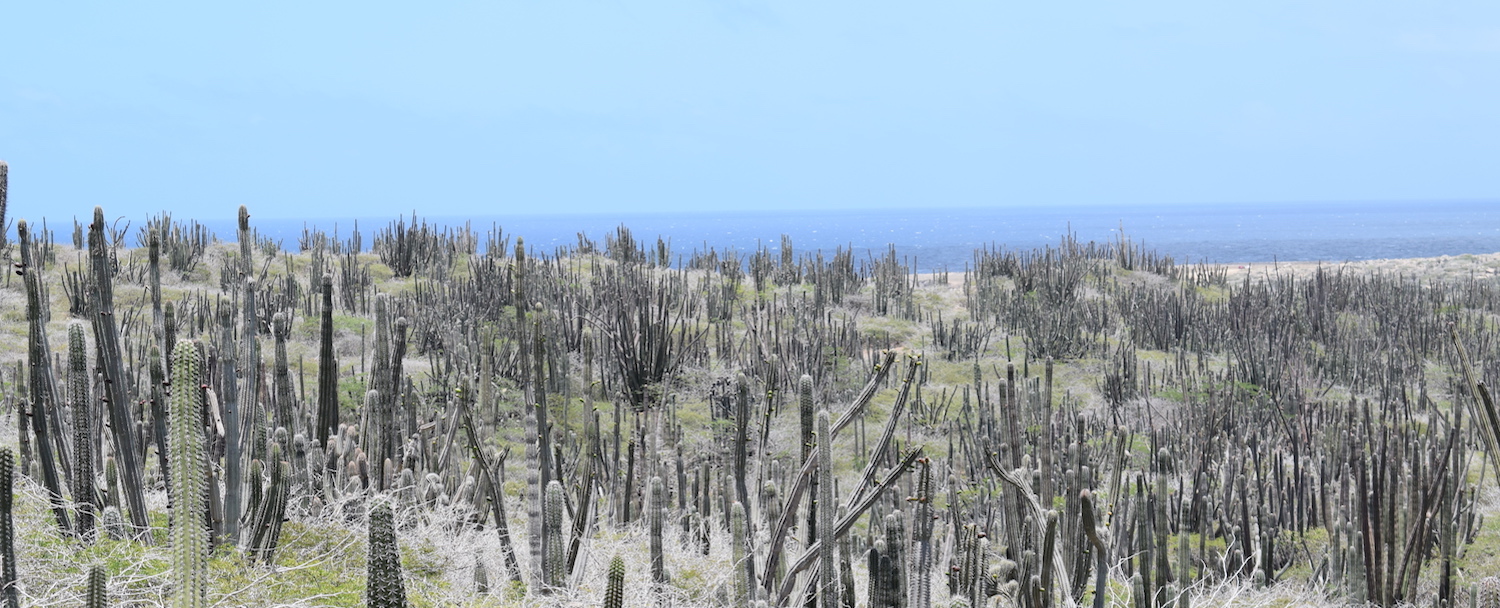
For geographical and historical reasons as well as alphabetical ones, the Caribbean ABCs are generally grouped together, even though these days they are no longer part of the same country, and they are culturally highly distinct from each other. There is brilliant diving on all three islands, especially on Bonaire, there are awesome beaches on Aruba, and in Willemstad on Curaçao there is a colourful old colonial city to explore.
The ABCs were formed by separate volcanic eruptions north of Venezuela (which is just 20-odd kilometres from Aruba) so it is not surprising that the earliest inhabitants were Arawaks from Venezuela, in the tenth century. They were discovered by Spanish explorers in the late fifteenth century and from the 1630s the Dutch conquered Aruba, Bonaire and Curaçao as well as fellow Caribbean islands Sint Eustatius, Sint Maarten and Saba to form what became a unified dependent colony of Holland, where slaves were sent to be traded or labour in the fields and salt lakes until abolition in 1863.
In 1954, the six became a single country: the Netherlands Antilles, administered from the largest island, Curaçao, under the Dutch crown. That was dissolved in 2010. Aruba, Curaçao and also Sint Maarten are now all autonomous countries within the Kingdom of the Netherlands (Aruba and Curaçao each have a local currency, florins and guilders respectively, with equal parity and subject to a common monetary policy set by single central bank based in Curaçao, an offshore financial centre). Bonaire, along with Sint Eustatius and Saba, are designated special municipalities of Holland, and use the euro.
These differences are all rather more evident in the culture than in the byzantine political structures. In reality, Aruba is targeted squarely at US tourists and offers US power sockets, accepts US money, and deals in US attitudes; it has by far the most developed tourist infrastructure, with big hotels-cum-casinos and a brash nightlife; this petite island is the sixth most visited place in the Caribbean by Americans. Bonaire is home to fewer than 20,000 people and prides itself as an eco-destination; there are European power sockets and a heavy Dutch lilt in the spoken English. Much the biggest of the three, Curaçao has a vibrant economy beyond tourism, displayed in its charming and historic capital, founded on oil and banking, a kind of Holland-in-the-sun.
There are plenty of similarities too. The official language taught in schools in all three is Dutch, though everyone also speaks Papiamento (a blend of Dutch, English, Portuguese and Spanish dating back to the slave trade) as well as English proper. And – uncommon for the Caribbean – all three are welcoming for LGBT travellers, proud that same-sex partnerships are legal (“we live and let live” says the community website Gay Curaçao, for instance).
None are classic chilled Caribbean destinations. But they all have year-round sun, with a good breeze to blow away the humidity, below the hurricane belt, with the promise of biba dushi or sweet life. Though they are much busier over the technically dry season, especially New Year, during the nominally rainy season, the northern summer, when showers can come down hard for fully 10 minutes about once a week before the blue skies return, we found no trouble booking local airlines or accommodation the day before we needed them.

Long-haul flights arrive mostly from Miami or Amsterdam, then it is just 20 minutes from Aruba to Curaçao, and another 15 minutes on to Bonaire. Aruba Airlines and Insel Air (which recently lost some slots because of safety concerns and terrible reliability records) fly all permutations of these routes, and several local specialists including Divi Divi Air also shuttle around in tiny planes.
Aruba
At first glance, you might think it unlikely that a primarily cruise-ship and US tourist destination – the bachelorettes were out in force when we were there – would qualify for a list of adventurous destinations. And without being part of the ABCs perhaps it wouldn’t. But of course under the skin there is more to this Caribbean paradise than five-star all-inclusives.
Aruba is flat, almost a parallelogram, 30km by 10km. The self-proclaimed “One Happy Island” (on your passport visa stamp at entry as well as emblazoned on everything from T-shirts to car number plates) is stuffed with I Heart Aruba merch.
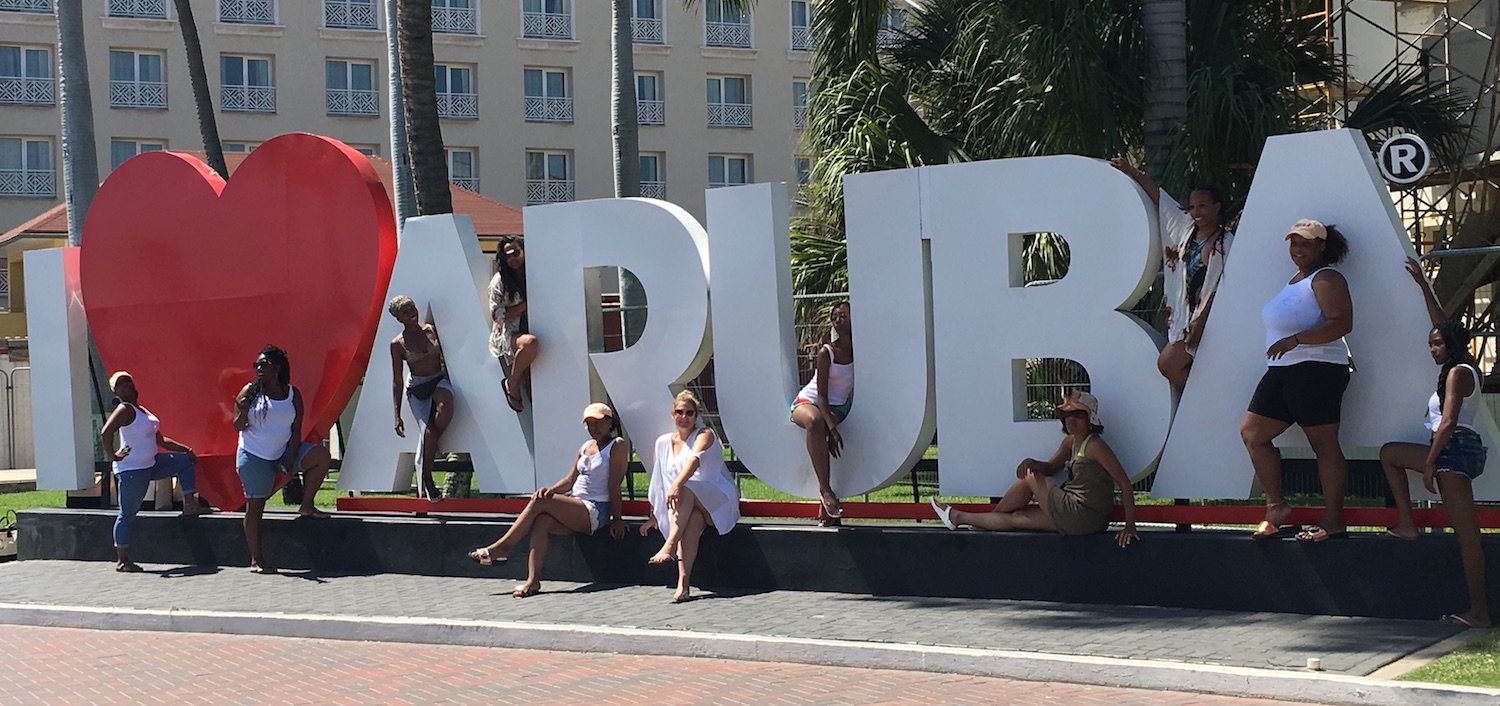
Oranjestad is a nondescript Dutch-US mash-up on the south coast just 5 minutes to the west of the airport, facing a couple of oil rigs a few miles out to sea, though they hardly disturb the gorgeous panorama. This is a shopping magnet for cruise-shippers looking for tax-free watches and jewellery, though for other items beware the old US scam of adding about 50% to the advertised price to cover taxes when you come to pay. There are also casinos and several South American restaurants, the pick of which is surely El Gaucho.
For those who have come to stay longer than just a day an all-American option is to rent a condo at one of the time-share developments a little west of the capital. Divi Village Golf and Beach Resort is typical, where golf carts will trundle you between various pools and bars, past the roaming iguanas, to the immaculate white sandy beach lined with thatched parasols you can believe were put there solely to foreground the catalogue photos of the cerulean water beyond.
Otherwise the two main beaches are a little further round the coast. On the south-west corner is Eagle (or low rise) beach, faced on the other side of the ocean road by a spree of small hotels.

Further up the west coast is Palm (high rise) beach. Here, the massive five-star hotels/casinos swallow up the sand and the views, starting with the Rui Palace, then the Hilton, Barceló, Hyatt, Playa Linda, Holiday Inn, Marriott and ending with the Ritz-Carlton.
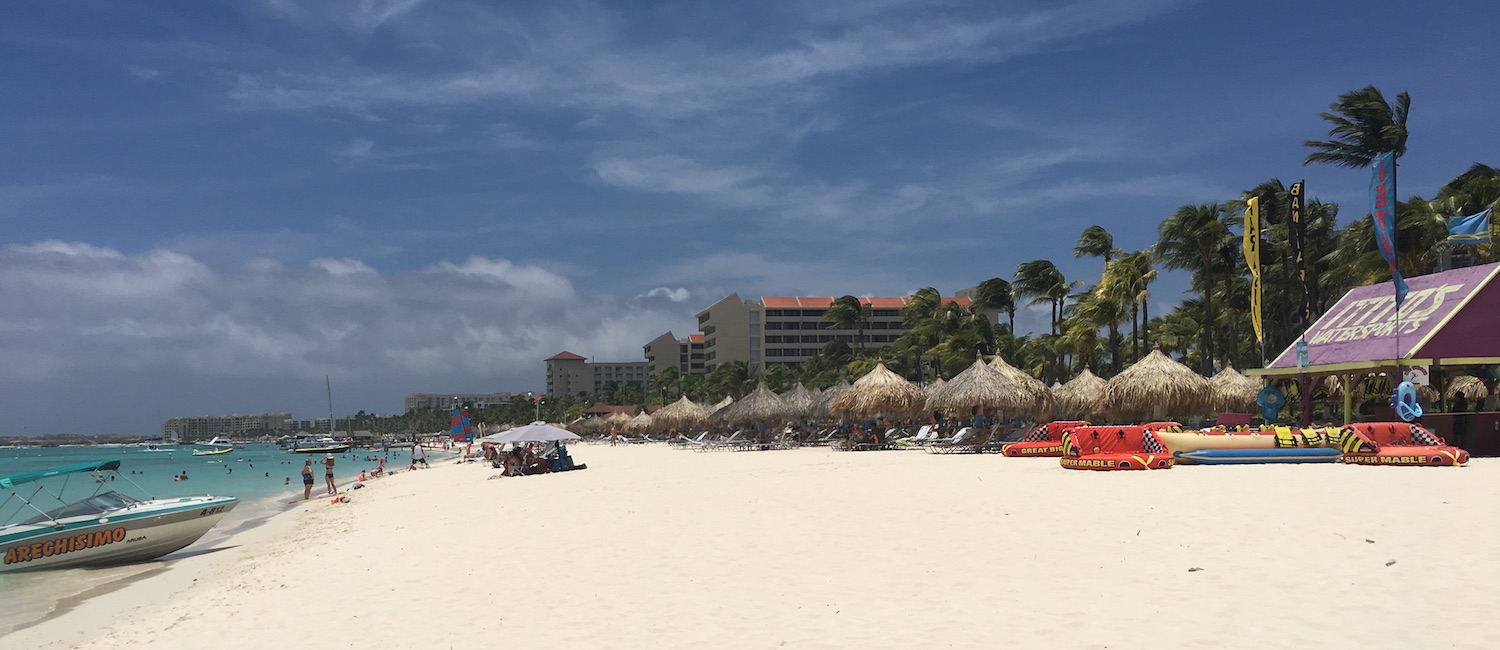
You can rent a car at the airport or from any hotel, and it is worth it to trace the coast road past a series of stumpy beaches studded with palms and cactuses until you reach the California Lighthouse on the north-west tip, where you can get a sugary fruit smoothie or a coconut with a straw and hire a jeep by the hour to bash the dunes around about.
If you double-back and head up to the windier, choppier waters of the north coast you will come to the Arikok National Park, either an unimpressive 5km drive along a tarmac road or a bit more fun if you go off-road or do some hiking. Exit on the east side and aim for the town of San Nicolas on the south-east corner of the island. Keep going around the eyesore of the old oil refinery that once made Aruba of strategic interest to the US until you see pleasant Rodgers beach on your right. As the road arcs round you will suddenly see the star of the show on your left: Baby beach.
Baby beach is a near complete oval with a small gap between the arms of the rocky breakwaters that reach out to sea, creating a virtual lagoon of deep blue. For 500m runs bright white sand, populated almost entirely by Arubans with only very few foreigners bothering to make it out here as they stay mostly in their hotel compounds back west. On the weekends, locals can be found dancing to Reggaeton tunes blaring from home-made speaker systems rigged up in pick-up trucks in the parking lot behind, or BBQing right under the signs demanding “no fires”. But there is plenty of room for all comers. At the east end is the fabulous Big Mama Grill, crammed with characters straight from central casting, chomping burgers and quaffing beer in a great vibe with a warm welcome that many people travel to the Caribbean precisely to find.

It’s just half an hour back again along the south coast to Oranjestad and on to the tourist enclaves. Along here there is a bit of decent diving, including the main attraction, the wreck of the Second World War US cargo ship Antilla, 10 minutes off Palm beach. Scuttled in 1940 when Hitler invaded Holland, the 122m hull is covered in life and as the superstructure is but 5m deep, snorkelers come here too to see lots of small fish as well as occasional rays and turtles.
Bonaire
By far the best diving in the ABCs, and among the best in the whole of the Caribbean, is to be found at Bonaire. An upside-down L-shape, Bonaire is less than 40km from top to toe; the uninhabited satellite island of Klein Bonaire nestles just 1km off Kralendijk, the small main town that sits on the right-angled turn on the west coast. All flights arrive over Klein Bonaire and from the left of the plane you can clearly see the reef system around the islands under the transparent ocean.
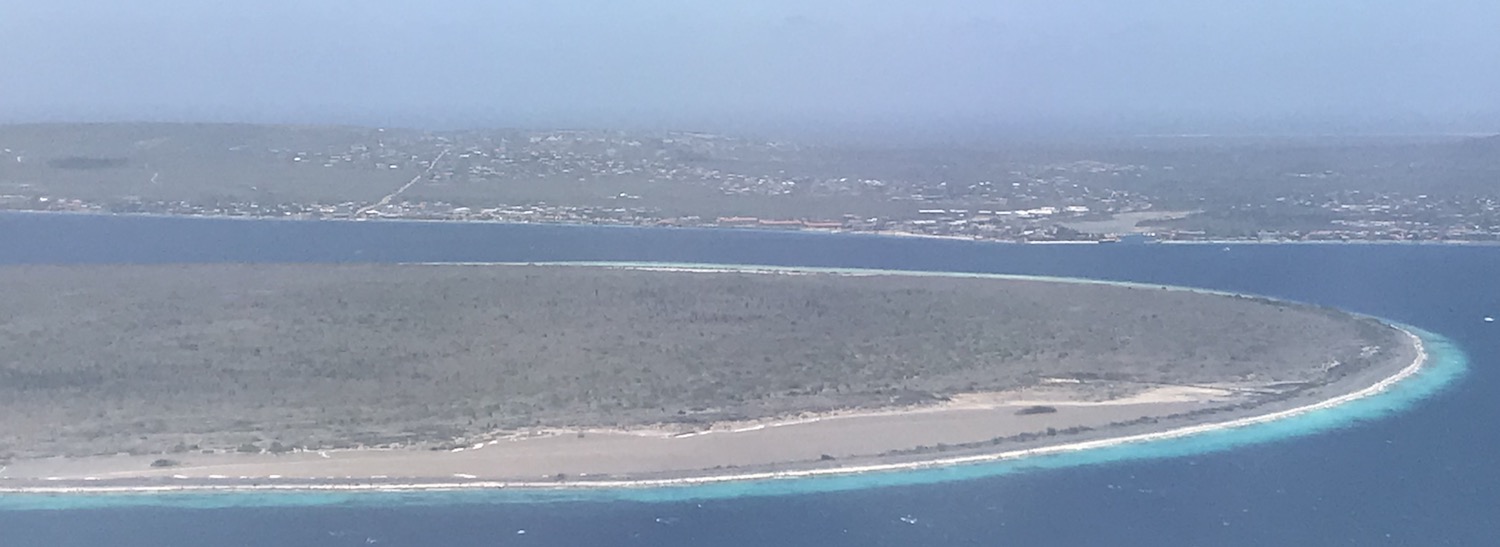
This is not your standard-issue Caribbean paradise: there are no white sand beaches lined with swaying palm trees, for starters; the coast more or less all the way around is a rubble of small rocks and dead coral. I can’t imagine why the cruise ships bother stopping here and the day-trippers must leave after a two-hour stroll about town wondering what that was all about: there are a few nice local stores, but it’s nothing like the archetype they find in Aruba or the big city in Curaçao.
“Divers Paradise” (sic) is emblazoned on every car number plate and this is the self-proclaimed world capital of independent shore-diving. Everything here is geared up for that. This eco-destination (there is no trawling, and there are strict regulations on anchoring at sea and building on land, so there are really only two small towns: Kralendijk, and Rincon to the north) is a long, long way from Aruba.
There is a diddy Marriott near the airport and a few boutique hotels in town. Apart from that the main accommodation options are either one of the low-key dive resorts such as Captain Don’s Habitat (home of Don Stewart, who set up the first dive shop on the island as far back as 1962 and then helped found the National Marine Park in 1979) and Eden Beach, or to go self-catering.
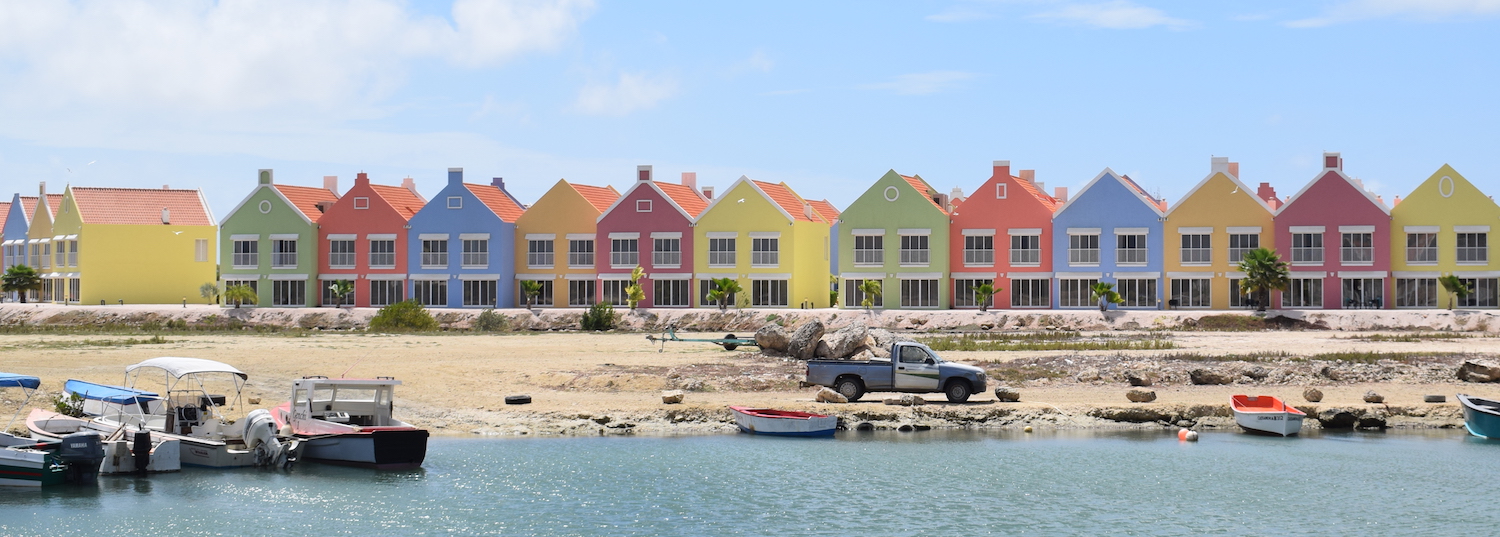
There are pleasant large family houses for rent by the canal in the gated-community of Water Villas, all painted in bright colours in homage to Holland and aping Curacao; and there are lots of guesthouses and Air BnBs all over town. The modern apartment complex of Terramar is smack in the centre. It can be noisy on Friday nights when the normally sleepy village metastasises into a wannabe party town, but from here there are unbeatable views of Klein Bonaire, especially stunning at sunset (except on Tuesdays when the cruise ship docks right in front). The main drag, Kaya Grandi, is lined with boutiques and places to hole up for food and drink. You can also load up with supplies at one of the many supermarkets down Kaya Industria, starting opposite the Flamingo Casino.

For an eating out novelty, try the Islander, where the menu is a lucky dip: you are charged $7 per dish and $5 for a pairing wine but you won’t know what you’re getting until it arrives at your table. There are also several great places on the sea front, notably Karel’s on the decking over the sea, and nearby It Rains Fishes, with the catchy strapline “drink eat fish repeat”.
To go diving, first you’ll need a pick-up truck to ferry your gear around the island. You can hire one from the line of huts outside the airport that is home to every major rental company going. Next you’ll need some tanks and any kit you didn’t bring with you. You get these from any of the dive shops in town: apart from the dive resorts there are several Five-Star PADI centres including Buddy Dive, Dive Friends, Divi Dive and VIP Diving (where we found the DMs a bit curt) along with lots of small places too. For a flat fee, you take as many cylinders as you like, returning your empties at the end of each day and getting some new fills, including Nitrox of course, the following morning. Then you’ll need a STINAPA Foundation permit to enter the National Marine Park and Washington Slagbaai Park nature reserve. Simply pay your dive shop $25 each for these. Last, you’ll need a map of the dive sites, and these are available everywhere. Then you’re good to go off on your tod.
Independent shore-diving: unhampered by busy-body DMs and poorer quality divers. It’s certainly not as chilled as a liveaboard or having a dive shop lug all your gear about for you. But it does feel adventurous, as if you are the very first people to explore a site.
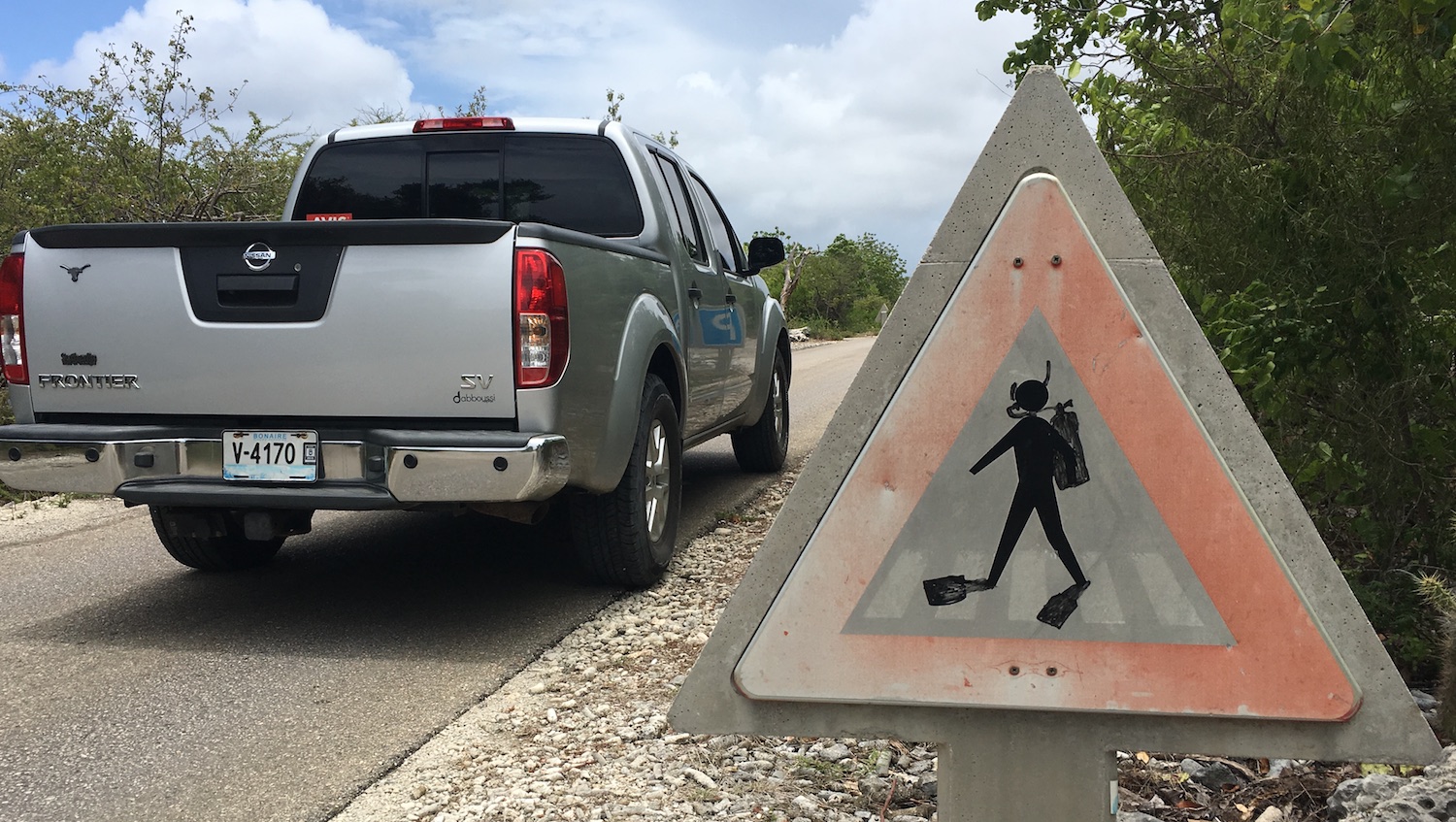
There are two hazards worth noting. First, you are advised not to leave mobiles, cameras and other valuables in your pick-up while diving because locals have been known to break in and take them. Second, be careful when parking near some dive sites as it is easy to get your non-4×4 pick-up stuck in the rubble, which will require roadside assistance that is hard to get if you follow the guidance on how to avoid the first menace.
The dive sites are numbered on your map from 1 to 63 north to south down the sheltered west coast, and each is correspondingly marked with its name on yellow boulders by the road side and yellow buoys just out to sea. There are also pillars of stone to identify the easiest entry points into the water. You see pick-up trucks cruising the west coast all day, virtually the only traffic, and in some places, especially near to Kralendijk, clusters of them can be found parked every hundred metres or so at such sites. Some are more famed for their entry than their dive. For instance, number 16, called 1,000 Steps because the 70-odd actual steps up the 20 metres or so from the beach to the car park can feel like a thousand after a long dive, and number 10, La Dania’s Leap, where you need more than a giant stride off the rugged cliff edge into the sea.
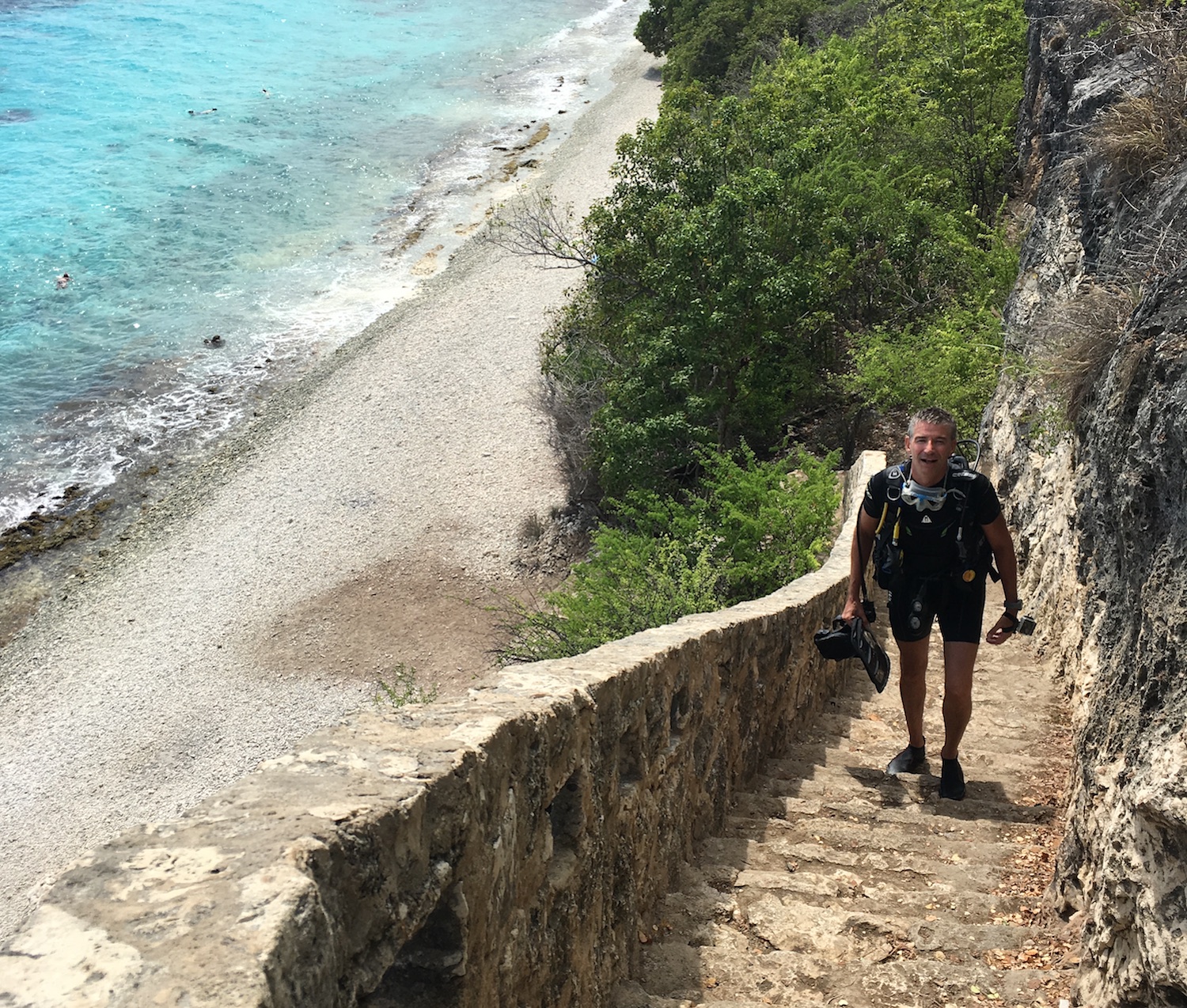
In reality, it is one continuous reef and you can wander in off the beach more or less wherever you fancy. You may prefer to head furthest north and south to avoid the crowds and find the healthiest corals with the most life. In these more remote areas, some entry points have been highlighted by amateur enthusiasts, and it is certainly unusual to look for the bottle-on-a-stick that some bloke you met in the dive shop mentioned. (For a particularly good bottle-on-a-stick dive up north, follow the dirt road right to the edge of the Bopec station, skirt around the perimeter fence until you hit the coast again, and instead of taking the obvious route right turn left and head onto the beach there; it’s worth it.)
Although there are of course variations, in general there is usually a sandy bottom that stretches out from the rocky shore anything from 2 to 50 metres, often at shallow depths of no more than 5m. The reef begins to pick up until the drop-off which can be anywhere from 8 to 18 metres and runs down to 30 or 40 metres where the bottom becomes sandy again. Important local corals include massive elephant’s ears and jutting staghorns. You will always find loads of small fish creating colourful collages, moving patterns silhouetted against the sun above, as well as rays and turtles. A common and beautiful sight are shoals of blue tang and surgeonfish descending on the coral like locusts.
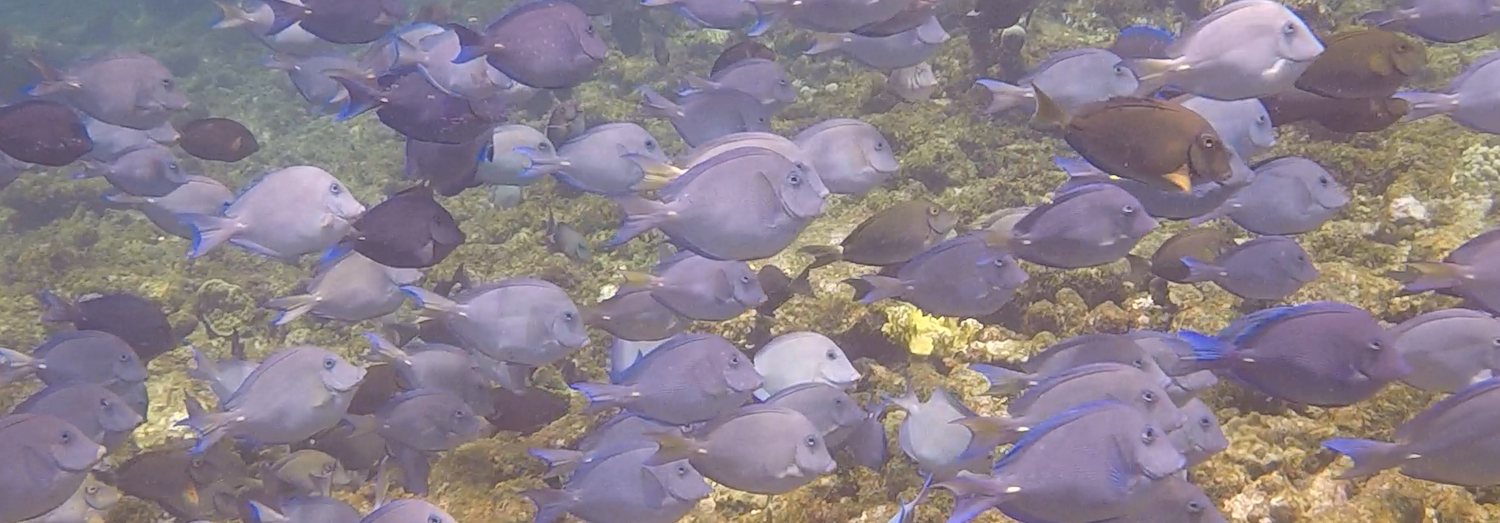
On the south-west sites in the 40s and 50s there is an unusual double-reef system. At number 43 is the wreck of the Hilma Hooker, a cargo ship – often carrying illicit substances – that has been lying at 25m on its starboard side since it sank in 1984, smothered with small fry as well as home to a few massive tarpons. At number 49, the Salt Works Pier, it is easy to find seahorses.
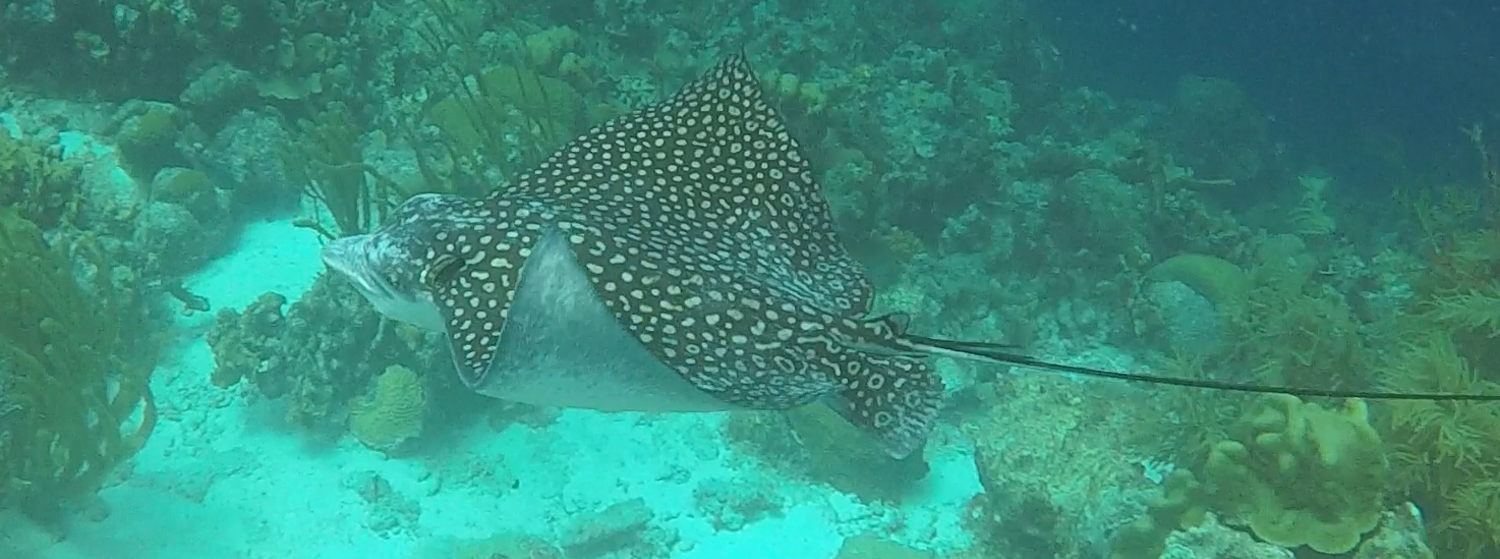
We had some breath-taking dives on Bonaire. At number 9, Karpata, in the late afternoon on the full moon we found scores of pairs of creole wrasse engaged in their mating dance, where the slightly smaller bright blue females are shadowed side-by-side for up to 15 minutes by the larger males who intensify in golden colour as the ritual goes on.
At number 54, White Slave Huts, we got very lucky with a once-in-a-lifetime experience (though similar things are reported from time-to-time so it’s not unique on this south-west coast). At the drop-off there the currents can go every-which-way and that is where we became entangled in a giant school of sardines, what is known as a bait-ball. It is hard to accurately estimate numbers, but there were many, many thousands, sheltering together for safety and trying to use our bodies to ward off the barracudas and jackfish that were stalking them. They swarmed around us back and forth for as long as fifteen fantastic minutes, blankets of tightly-packed sardines cutting the view of anything else in all directions.

To dive in the far north, where the waves are bigger and the currents stronger, you need to drive through Washington Slagbaai Park, an excellent spot for bird-watching and hanging out with iguanas that can grow as long as 2m. Don’t forget your permit and picture ID or you won’t get past the rangers to get in.
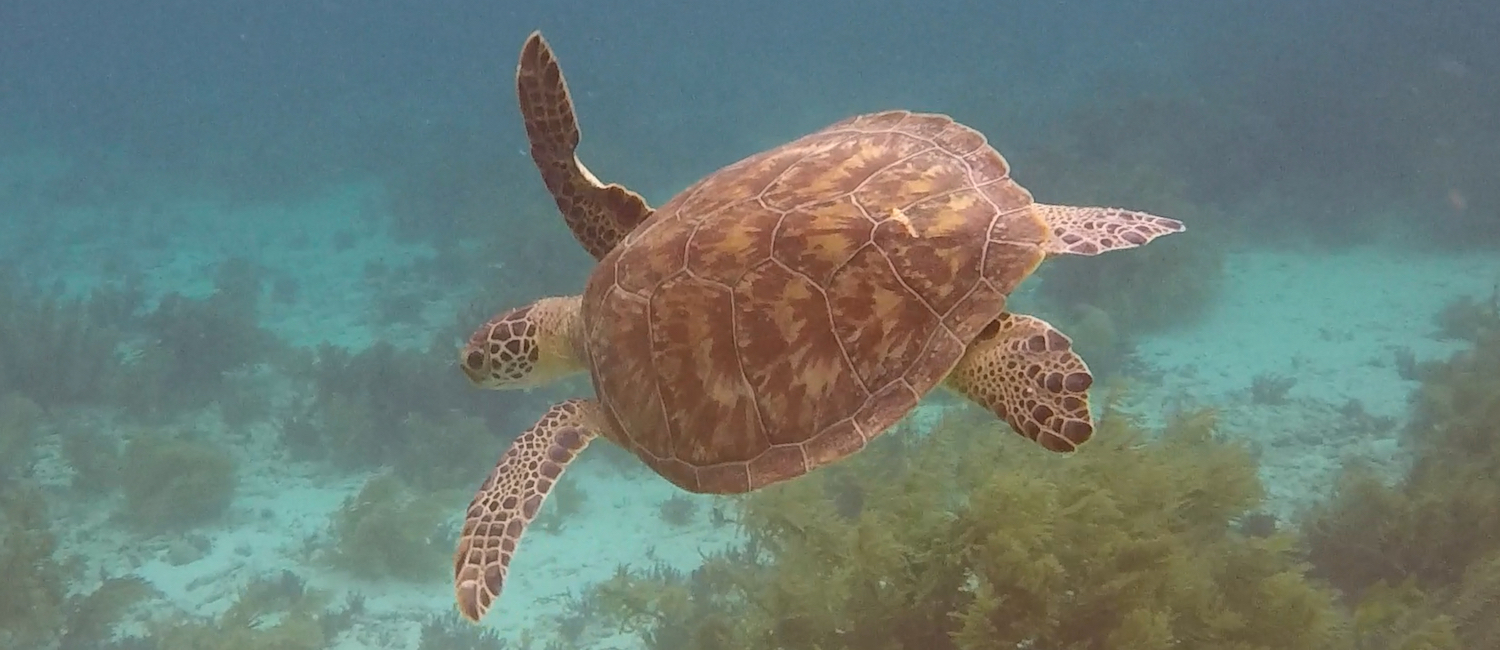
The south is more or less all taken over by the desolate salt lakes from coast to coast, leaving just the road between the pink ponds on one side and the blue sea on the other running down to the Willemstoren Lighthouse.

This is the best place to see pink flamingos, although they can also be found in both Aruba and Curaçao. Here you can get to within 50m or so of large flocks and it is an amazing sight when these flame red birds take to the deep blue sky.
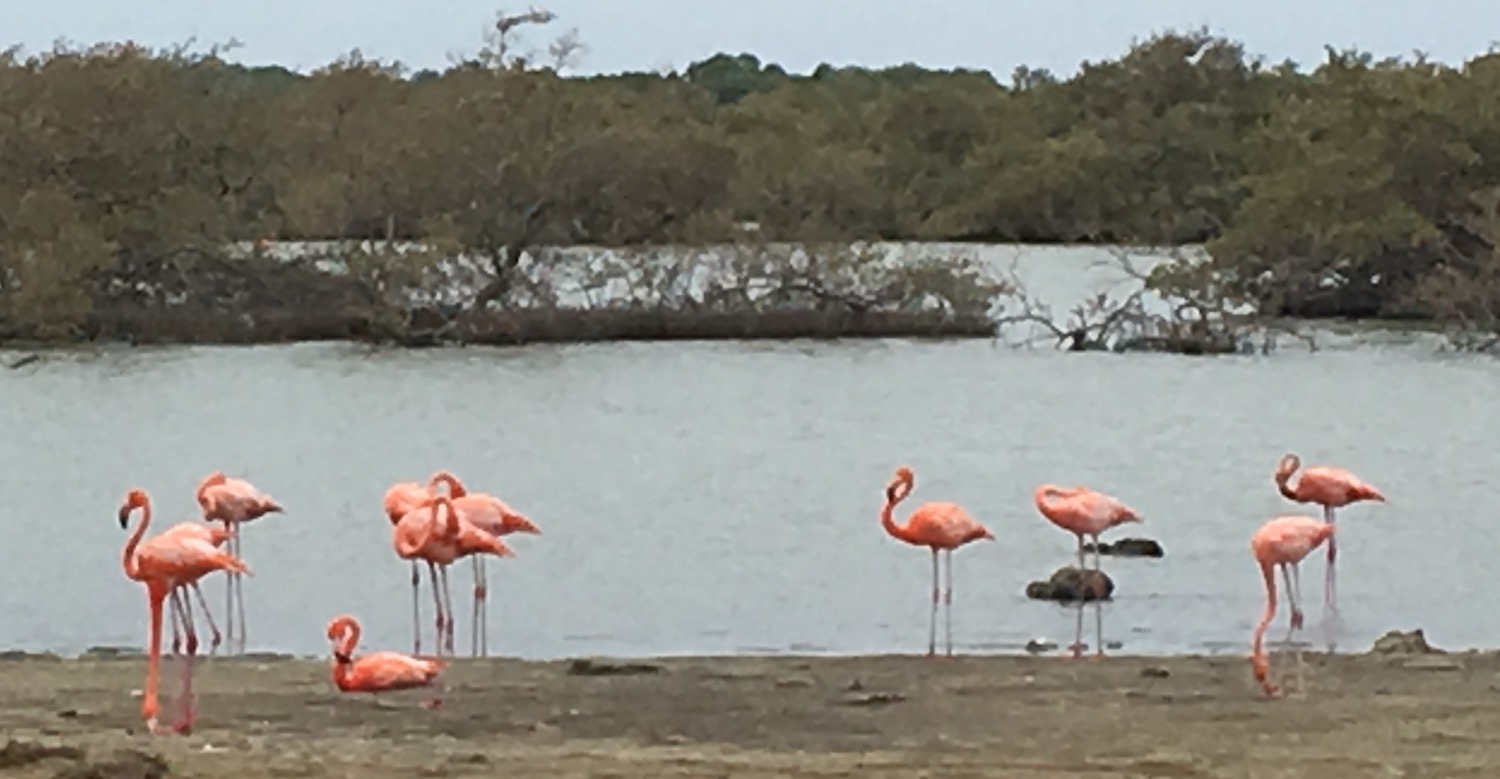
Near here are two clusters of slave huts: one called white and one red (though those are in fact yellow). They were built in 1850 to house slaves who were forced to collect and ship the salt. Near the white slave huts is the main area for kite-surfing.

In addition, there are 26 dive sites on Klein Bonaire (marked, naturally, A to Z on your map), where you will also find No Name beach, the best around these parts by far. These are all reached by boat just 5 minutes from Kralendijk. You can jump on one run by the dive resorts. On top of all that, you can dive the east coast of Bonaire too, for healthier coral and bigger pelagics. But this is the windward side of the island and the sites are not marked, so it is a more conventional experience with a local guide you can sort out at your dive shop.
The only beach to speak of on Bonaire itself is found on the east coast, at gorgeous Lac Bay lagoon, which is also the home of world-class windsurfing. There are several places to stay, eat, drink and hire stuff: the Soroban Beach & Wellness Resort, Jibe City and the Beach Hut Bar & Grill. A little further along are picnic and BBQ facilities, with tables set out under thatched roofs.
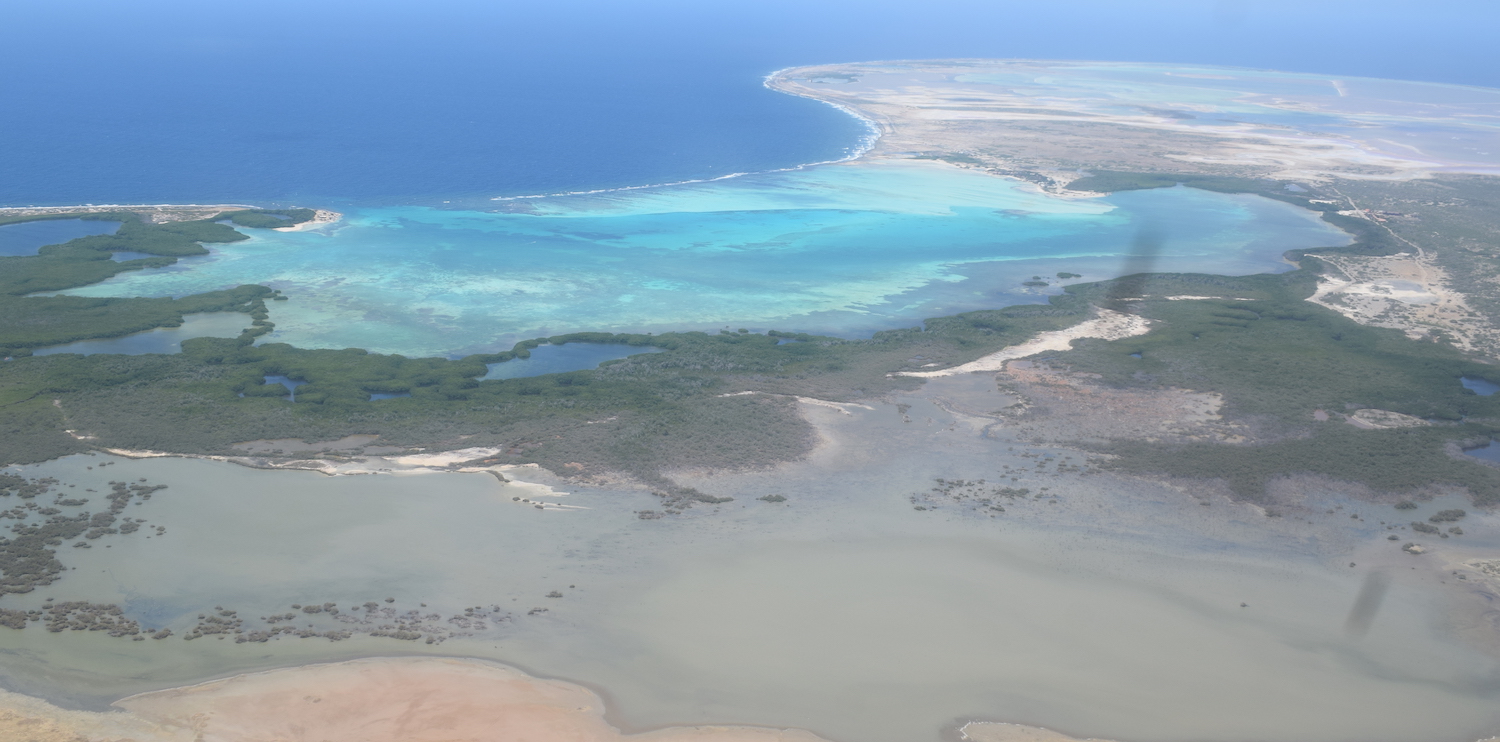
If you drive back from the beach down the road that sweeps around the bay, past a score of holiday villas and Foodies, then turn right onto the dirt track just after the Red Palm Village, with its stunning cactus fencing, you will pass the Mangrove Info Centre, where you can hire kayaks to explore the mangroves. Around here are more great views of pink flamingos close up. Right at the end you will come to the tiny fishing village of Lac Cai, and mini Lac Bar, where on Sundays you can join the locals in a polystyrene box of conch and polenta while listening to an authentic local band. Just lovely.
Curaçao
Curaçao, the old capital of the Netherlands Antilles, is the biggest of the ABCs, housing by far the largest city, Willemstad. The historic colonial centre is a UNESCO World Heritage Site that is the principal reason for coming here. Willemstad also hosts the oddly titled Curaçao North Sea Jazz Festival, a significant Caribbean annual event which we deliberately timed our trip to attend. And on the island there are one or two pleasant beaches and some worthwhile diving as well.
Unlike Aruba and Bonaire, Curaçao has more important sources of income than tourism: oil (there’s a massive refinery) and banking (it’s a tax haven). Its other chief exports are aloe vera, Blue Curaçao Liqueur (made from native bitter laraha oranges and which in fact tastes just the same as the clear, green, orange and red versions; the colour is just a marketing gimmick) and MLB baseballers. Its economic success has understandably made it attractive to recent migrants fleeing from Venezuela looking for sanctuary and employment, creating social issues familiar to developed nations.
The island runs at an angle from north-west to south-east and Willemstad is set in a stunning topography on the south-west coast. The hills, alive with houses painted in every colour under the sun, roll down to the sea, where the Sint Annabaai River splits the city in half – with Punda to the south and Otrobanda to the north – on its 2 km way from the open Caribbean to the deep port of Schottegat. There is a high roadbridge to the east of the city that gives a wonderful panorama of the colour below.

Near the mouth, a very pretty footbridge – the Queen Emma Pontoon, or “Swinging Old Lady”, the oldest and longest floating bridge in the world – opens every half an hour or so to facilitate big ships accessing the port. When the bridge cannot be crossed there is a cute free ferry nearby that whizzes across the water every few minutes.
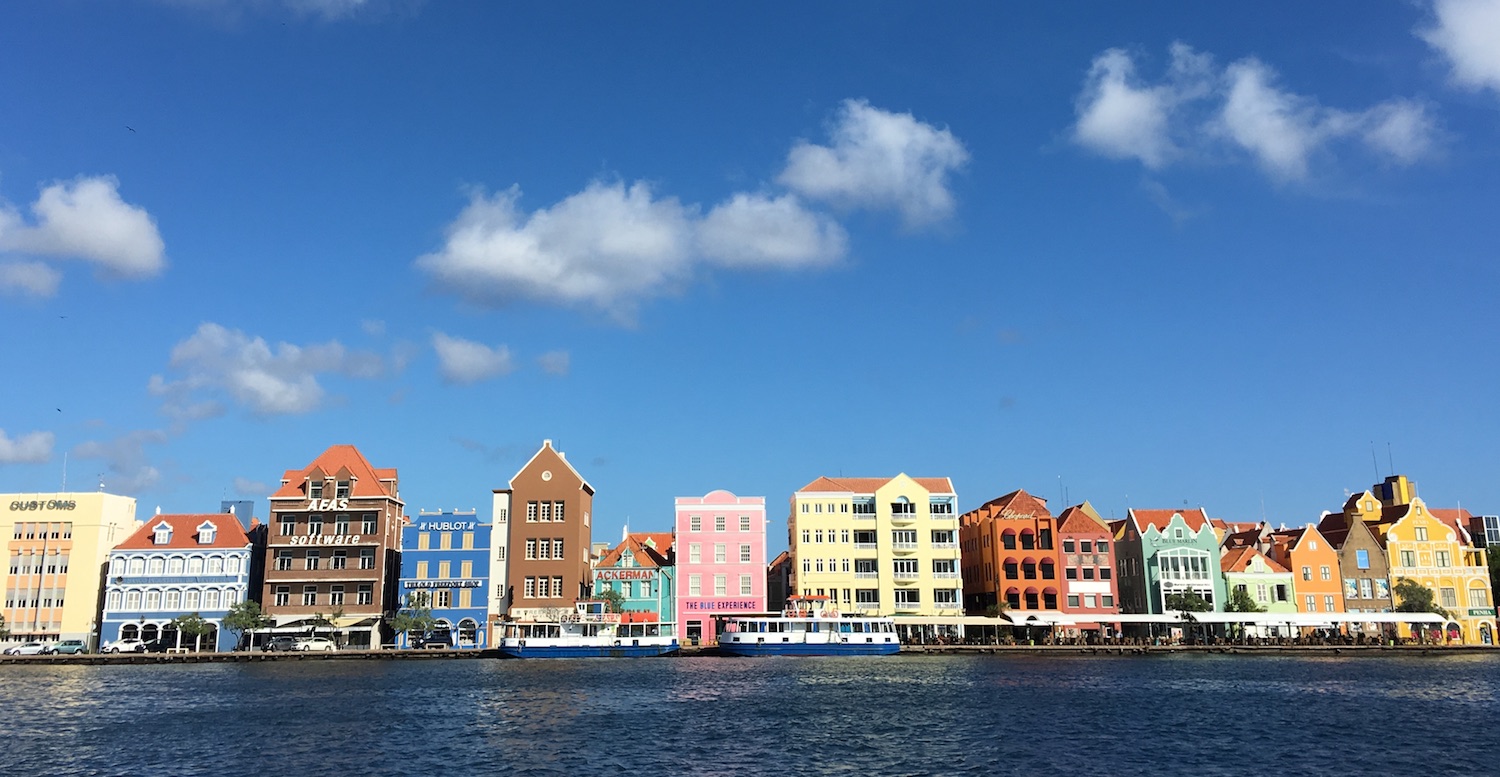
On the south side directly facing the river is Curaçao ‘s most iconic landmark: a terrace of fifteen or twenty colonial buildings, each a different shape and a different pastel shade, with ancient wooden shutters and angular rooftops. You will see pictures of it everywhere, even printed on every car number plate. Just in front of this row, right on the water, is a series of tables under parasols that comprise contiguous bars and restaurants. Iguana Cafe is the ideal place for whiling away the time, people-watching, kicking-back with a locally brewed Dino’s Red Ale as the bridge swings open to let through huge tankers guided by tiny pilot boats while pedestrians buzz around the ferry docks, all as the sun sets over the water.
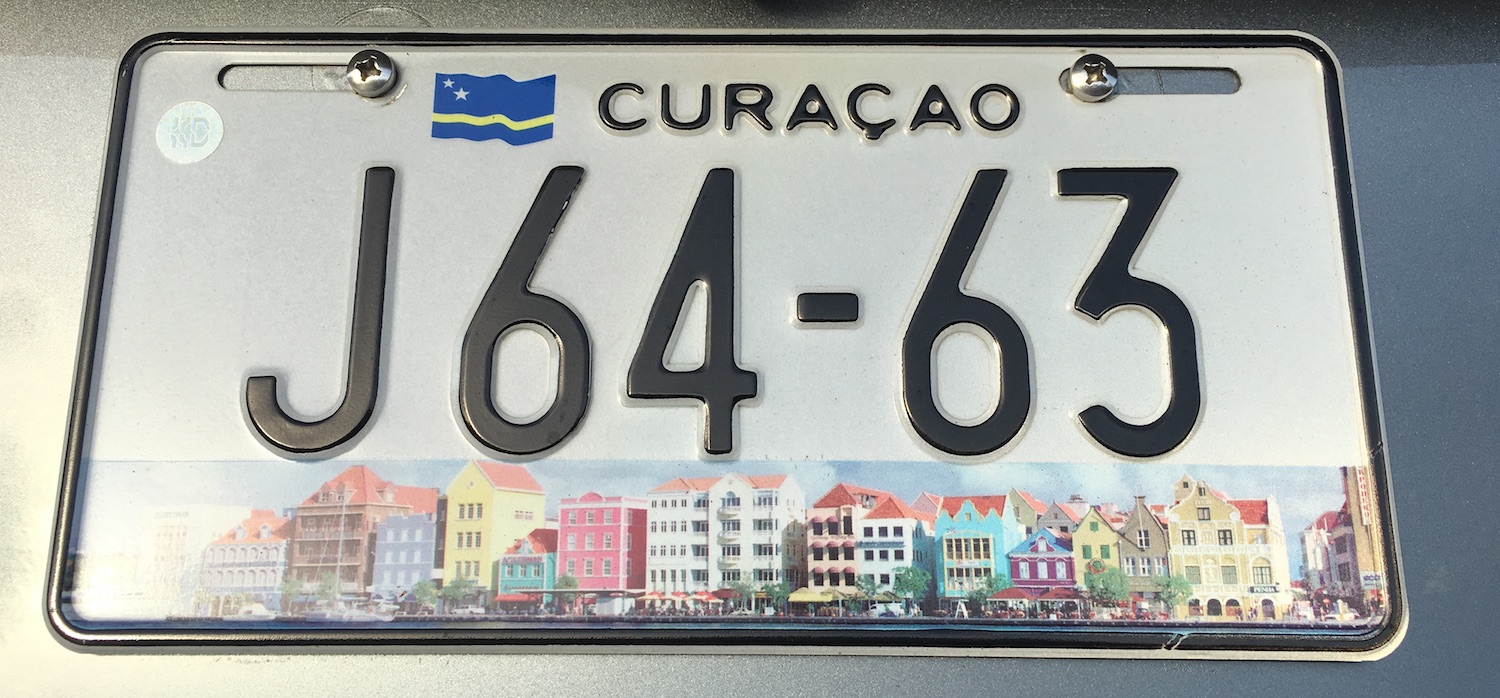
At the south end of the bridge is what feels like the only taxi rank in town. Behind here is the main tourist district of Punda, all authentic cobbled lanes that could have been designed for a movie set, with a relaxed vibe of boutiques and juice bars, including shady blokes offering you spliffs and coke to complete the Dutch feel. This is the place for meandering during the day, though surprisingly it is all shut up at night.
Nearby is the Mikve Israel Emanuel Synagogue, the oldest continually operating Jewish congregation in the western hemisphere. There is a small but fascinating museum in the original eighteenth century rabbi’s residence. At the turn to Waaigat basin is the floating market, a series of fruit and veg stands supplied by up to a dozen fancy wooden boats moored there having come all the way from Venezuela to sell to the locals.
Further south and east, between Waaigat basin and the Caribbean coast, is Pietermaai, a very cool neighbourhood of finely restored colonial buildings, splashed with colour obviously. There are several gorgeous hotels right on the sea, notably Bij Blauw and Scuba Lodge, both in historic houses with restaurants facing the ocean. In the square opposite are two highly-rated restaurants, Cristal and Kome. Other good hotels here include Avila, the magnificent eighteenth century home of the Dutch governor right on a small beach, and Pietermaai Boutique, with wooden floors and high ceilings.
On the north side of the river, in the Otrobanda district of the old town, you get perfect views of scenic Punda opposite. The dark red Gouverneur De Rouville restaurant has the appeal of a great menu of local dishes (including banana soup, goat curry, and a weird mix of cheese and chicken) and an even greater attraction in the majestic veranda overlooking the river. Next door is the bright blue Otrobanda Hotel & Casino which also has a restaurant and a patio with a view.
There are loads of bars and restaurants in the cobbled courtyard of Rif Fort, near the Carnaval Casino and the Renaissance Hotel. Just around the corner is where the cruise ships dock, as many as three or four a week even in the off-season, but unlike Oranjestad and more so Kralendijk, Willemstad is large enough to hold them without feeling taken over.
Jazz and blues are a feature on the island. The Curaçao Blue Seas Festival has recently started every March in Pietermaai. And the more established Curaçao North Sea Jazz Festival attracts visitors over the first weekend of September every year. This is held at the World Trade Centre in the north of Willemstad, close to the Floris, which advertises itself as “adults only” and is in fact the centre of the local gay scene.
This is the junior partner to the original and now behemoth version held in Rotterdam every second weekend of July (hence the title). This year at least, it was poorly organised, with clashed scheduling (acts were timetabled against each other on the three stages, leaving gaps in between when nobody at all was playing) and prohibitive pricing (it costs $200 a day, though you get the third day free if you buy the other two, so for a couple to attend it’s $800, which is the average monthly wage on the island for locals) keeping the crowd down to maybe a thousand.
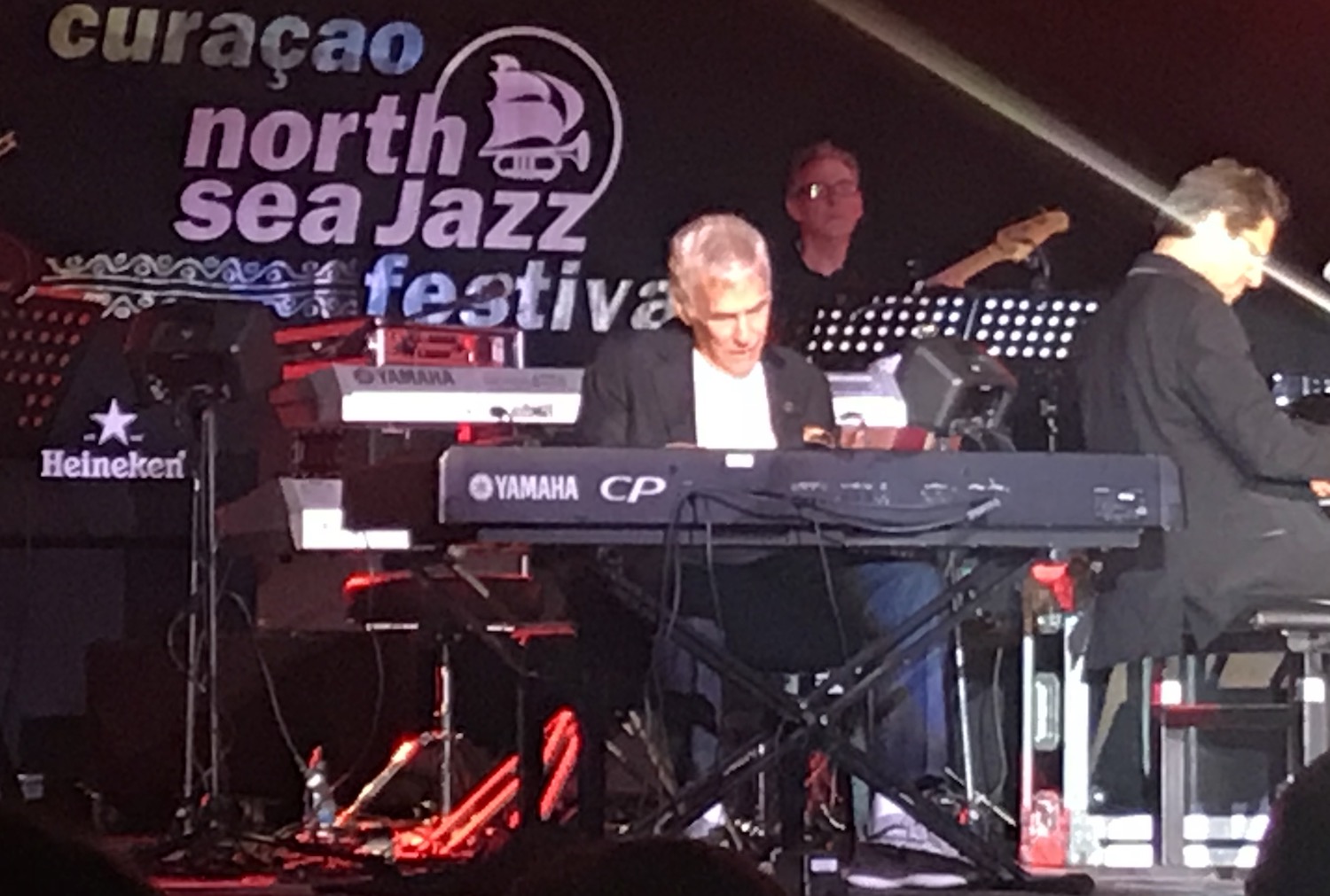
Despite all this, it does have big names, from Spyro Gyra to Grace Jones this year, and it felt like a highpoint of the trip to be there. The pinnacle was seeing Burt Bacharach, who at the age of 90 ran through his classic back catalogue to an intimate audience of no more than about 200 or so of us; what a privilege that was.
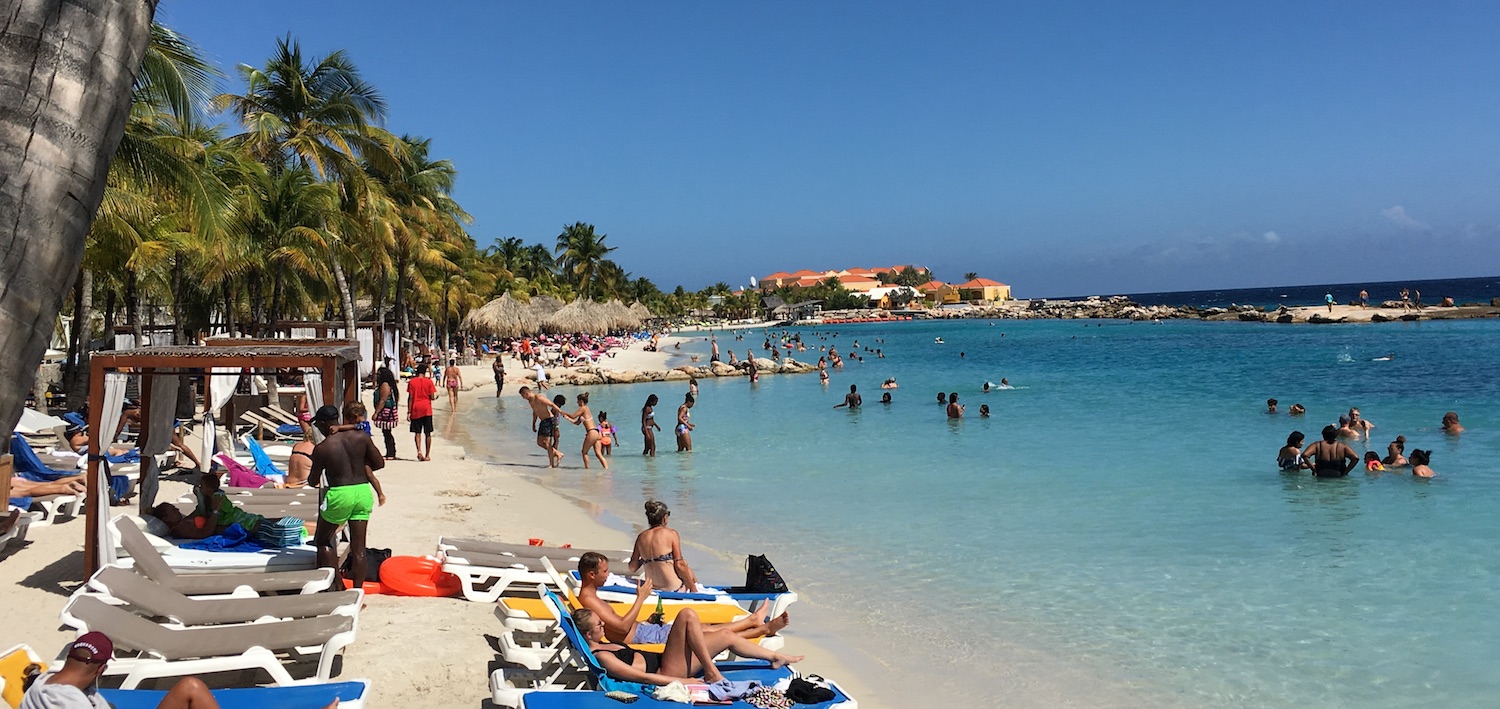
South-east of Willemstad is a pair of popular artificial private beaches. The closest, Mambo beach, is 1 km of prettily sculpted white sand with a barrier of rocks 50m out to sea creating an imitation lagoon the colour of Blue Curaçao Liqueur. There is a series of bars each with differently patterned loungers, and some decent boutiques set behind. By day, the Europeans bask in the sun while the Americans stand up to their waists in the water swigging bottles of beer. By night, this turns into “wet and wild” clubland. A little further down the coast is the slightly smaller and quieter version, Jan Thier beach.
The most picture-perfect beach though is up north at Kenepa, with fewer people and fewer facilities. The small public beach, jammed between two rocky cliffs, features in many of the travel brochures for a reason. Not far from there on Kalki public beach is West Point, a popular spot for snorkelers and divers to get up close with a dozen or so resident and friendly turtles.
There are other shore-dive sites down the sheltered west coast. There are several dive shops, some with corny names including Divers of the Caribbean in Punda and Scuba Do at Jan Thier beach, as well as in the big hotels around Willemstad. We got lucky with this rarely spotted Octopus out in the daylight.